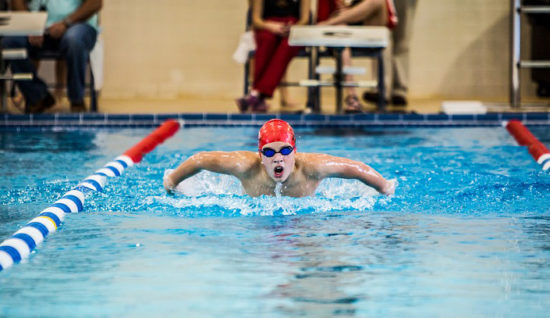Dry land programs for swimmers
Not every swimming program is fortunate enough to have its own pool, and that forces coaches to find innovative ways to train their athletes without stepping in the water.
 Because so many teams have been forced to adapt, coaches across the country have developed their own dry land programs. These strength, conditioning and flexibility workouts allow athletes to exercise the muscles and tendons essential to swimmers without having to fight for pool time.
Because so many teams have been forced to adapt, coaches across the country have developed their own dry land programs. These strength, conditioning and flexibility workouts allow athletes to exercise the muscles and tendons essential to swimmers without having to fight for pool time.
Kettlebells
The kettlebell has a number of uses to work the upper and lower body, and the kettlebell swing is one of the more popular choices. It’s ability to develop strength and explosiveness in the legs pays off for competitive swimmers.
To execute the move, stand with the feet shoulder-width apart and toes pointed out with a slight bend in the knees. Take a two-handed grip on the kettlebell between the legs — weight depending on the abilities of the athlete — and with an arch in the lower back, squeeze the glutes and extend the hips to swing the kettlebell up.
Allow the weight to take the kettlebell back down between the legs with the hips and knees bending to support the weight. Repeat the maneuver.
Squats are another important workout for swimmers, and kettlebells can help.
With a kettlebell in each hand, begin in the “rack position,” like you would with a traditional squat. Keeping the elbows down with the kettlebells resting on the forearms, squat down and drive the kettlebells above your head as you stand. Repeat the maneuver.
Kettlebells can be costly, depending on the weight and number you want to buy for your program, but when compared to other equipment in your facility, it’s a great alternative. It’s also mobile, allowing your swim team practice anywhere there’s ample room.
There are dozens of workouts athletes can do with kettlebells, so do some research to discover what meets the needs — or focuses on the weaknesses — of your swimmers.
Jump rope
 Cardio equipment is everywhere — stationary bikes, treadmills, ellipticals — but the beauty of the jump rope is it can be taken anywhere and used with relatively little space. It’s also incredibly cost effective for athletic departments that may not be able to heavily invest in its weight facilities.
Cardio equipment is everywhere — stationary bikes, treadmills, ellipticals — but the beauty of the jump rope is it can be taken anywhere and used with relatively little space. It’s also incredibly cost effective for athletic departments that may not be able to heavily invest in its weight facilities.
There’s no secret exercise to maximize the effectiveness of the jump rope, but what swim coaches must do is monitor their athletes individually, making sure they’re using it in a way that safely increases their heart rates. Ideally, your athletes would be making these strides in the pool, but regardless of how you choose to address cardio, it must be one of the focal points of your dry land program.
Enlist of the help of the school’s strength and conditioning coach to make sure you’re getting maximum effort and gains. If possible, track heart rates so you can identify which athletes are getting the most from your cardio sessions.
Abdominals
The best swimmers constantly work to improve their cores, and there are a number of workouts embraced by experienced swimmers that your athletes can use to achieve this.
Strength and stability is key, and crunches or bicycles are not always the best methods to improve one’s core. Consider planks and stability balls when working on the core, as traditional workouts don’t always have the best application for swimmers.
Another benefit to these workouts is they include a greater focus on the arms and legs, which can improve range of motion and flexibility in your athletes. Coaches are not afforded much time with their athletes, so take advantage of any opportunity you have to implement multi-purpose exercises into your routines.
These are just a few of the options coaches have when creating their dry land programs, but they’re three essential areas swimmers should focus on to maximize their potential in the pool. Depending on experience, strengths and weaknesses, workouts can be customized to meet individual needs, but just remember that not having a pool doesn’t entirely eliminate a swimming coach’s options when making improvements. It just requires a little creativity.


